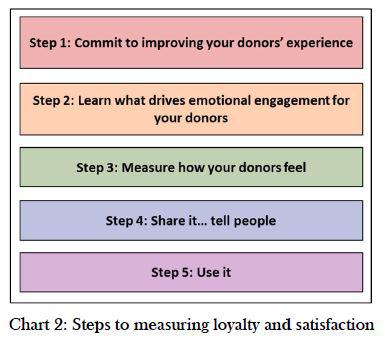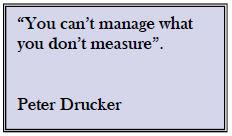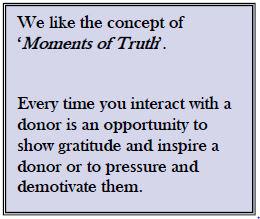CDE project 3 section 2: putting the principles and actions into practice — step 1 and 2
- Written by
- The Commission on the Donor Experience
- Added
- May 04, 2017
We have identified five steps that you should take to measure how donors feel and to use this to change the donor experience that you offer:

Step 1: Make a commitment to growing donor satisfaction and loyalty
How donors feel is vital

It’s always important to start by knowing why you are undertaking a particular approach, and this understanding should be shared with your colleagues.
There is a growing body of evidence that shows that how donors feel about us has a direct relationship with our ability to raise money from them in the long term.
Professor Adrian Sargeant (Professor of Fundraising at Plymouth University and the Director of the Centre for Sustainable Philanthropy, Plymouth University) has shown the impact on income of improving donor loyalty[1] and that loyalty and commitment to a cause are vital in developing long-term profitable donor relationships.
About Loyalty has shown that those donors with the highest levels of emotional loyalty to you give longer than those with lower levels[2].
Donor Voice has shown that donors in the top 25% for commitment will have given 131% more than those in the bottom 25%[3]. There is also plenty of anecdotal evidence that donors who have a very good experience go on to provide support in other ways and become valuable advocates.
Why is the commercial sector so far ahead of us?
The charity sector has led the commercial sector in our understanding of how emotions drive decision making and generate behaviours and responses, so it is ironic and disappointing that the commercial sector is so far ahead of us in understanding how our communications can make a donor feel about us and how those feelings then influence the future relationship they have with us.
Companies have long measured levels of customer loyalty and satisfaction, along with affinity for the brand. They discovered that increasing emotional loyalty through offering a better experience can differentiate a company from its competitors and grow customer loyally and profits. They have done this for one reason only – because they know that in the long run they can make more money by keeping their customers happy.
Now it’s our turn to learn from them.
Measure performance

If you are ready to make this commitment to improving your donors’ loyalty, then you need to measure your effectiveness. Only by having KPIs in place and measuring progress against them can you will give sufficient priority to making this change happen.
You won’t change it unless you measure it.
Commit to implementing a strategy aimed at offering a better donor experience in order to change how your donors feel about you, and commit to measuring the impact of this strategy on your donors.
Step 2: What do your donors want and need?
To decide what to measure, it is important to understand what your donors need and what makes them feel good about supporting you. In short, what creates emotional engagement between you and your donor?
You have to answer the question: ‘What is most important to your donors?’
What determines how your donors feel about you? The first thing to note is that this is, by definition, about emotions and about your donors.
To deliver the donor experience that will grow their loyalty, you need to listen to your donors’ needs, understand their motivations and learn how you can feed their emotions.
We could write an entire thesis on how to gather donor insight and what to look for, but there are some important points to note when thinking about these issues.
Emotional needs
There are as many reasons for giving to charity as there are donors. The experience we give them (through our fundraising, our communications and our supporter care and through all other touch-points with us that they may have) influences everything they feel about us. It is through these interactions that they form their opinions – almost entirely at a sub-conscious level.
We know from research that Loyalty (the feeling of support or allegiance that a donor has) is driven mostly by Commitment, Satisfaction and Trust. Professor Adrian Sargeant has found this in different research pieces that he has published[4], and recent About Loyalty research (with BHF, Cats Protection, RSPCA, Sightsavers and WWF donors) showed that these same three factors were the most significant drivers of a donor’s intention to continue giving to the charity they support[5].
In fact, the About Loyalty research found that these three factors, on their own, accounted for a massive 38% of the difference in a donor’s intention to continue giving. (Generally, anything that explains 10-15% of a person’s intention to behave differently is considered a significant factor.)
Loyalty (or Commitment, Satisfaction and Trust) is a good place for all charities to start.
We also know that emotion lies at the core of why people give to charity. Alan Clayton, who is an expert in this field, identified Need Emotions (anger, helplessness, compassion) and Reward Emotions (gratitude, pride and togetherness), which can be used to develop a donor’s emotional connection to the charity.
We haven’t even scratched the surface of the role emotion plays in giving with this introduction. Suffice to say here, meeting a donor’s emotional needs will have the biggest impact on changing the way they feel about you.
Rational needs

Professor Adrian Sargeant and Dr Lucy Woodliffe[6] identified the top factor that drives commitment to a charity as being service quality, which, again, the commercial sector has also discovered. This comes above other aspects such as shared beliefs, perceived risk (in stopping giving), a personal link or trust.
Service quality can be thought of as the way in which you interact with the donor at the moments of truth (see right).
Donors want to know that you are listening to them and responding to their needs. They want efficient, friendly service when they contact you. They want fundraising communications that have borne in mind their expressed preferences and needs. They want consistency across all channels or touchpoints.
Within this area, you may want to think about how you deliver the donor service – are you offering any element of choice to the donor, is your tone-of-voice correct, is it easy to reach you and do what the donor wants, do you resolve complaints quickly and well?
Service quality is vital, and the extent to which you exceed or otherwise their expectations will determine the donor’s satisfaction. Although we have termed these rational needs, meeting and exceeding them (or not!) affects how the donor feels about you – their emotional engagement.
References
[1] Various Professor Adrian Sargeant including Donor Retention: What Do We Know and What Can We Do About It? (2008)
[2] About Loyalty: Charity Loyalty Benchmarking( 2015)
[3] Various Donor Voice surveys
[4] Professor Adrian Sargeant: Relationship Fundraising volume 1 – where do we go from here? (2016)
[5] About Loyalty: Charity Loyalty Benchmarking (2015)
[6] Sargeant and Woodliffe: Building Donor Loyalty: The Antecedents and Role of Commitment in the Context of Charity Giving (2008)


















